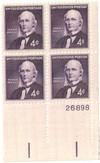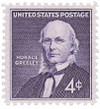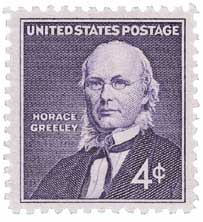
# 1177 - 1961 4c Horace Greeley
4¢ Horace Greeley
City: Chappaqua, NY
Quantity: 98,616,000
Printed by: Bureau of Engraving and Printing
Printing Method: Rotary Press
Perforations: 10 1/2 x 11
Color: Dull violet
Birth Of Horace Greeley
The son of a farmer and day laborer, Greeley received limited schooling until he was 14. After that, he found work as an apprentice with a newspaper editor in Vermont.
Greeley remained in the newspaper business, taking jobs in New York and Pennsylvania. Then in 1831, he sought to improve his life and returned to New York. He worked a variety of jobs for a while before he had enough money to start his own literary and news journal, the New Yorker.
Greeley’s New Yorker proved popular, but not lucrative, so he made extra money writing more on the side, in particular for the Whig Party. His support of the party and close connections to Whig leaders helped him become editor of the Whig publication, the Log Cabin. Under his leadership, the Log Cabin reached about 90,000 readers and helped William Henry Harrison win the presidency and Greeley gain influence.
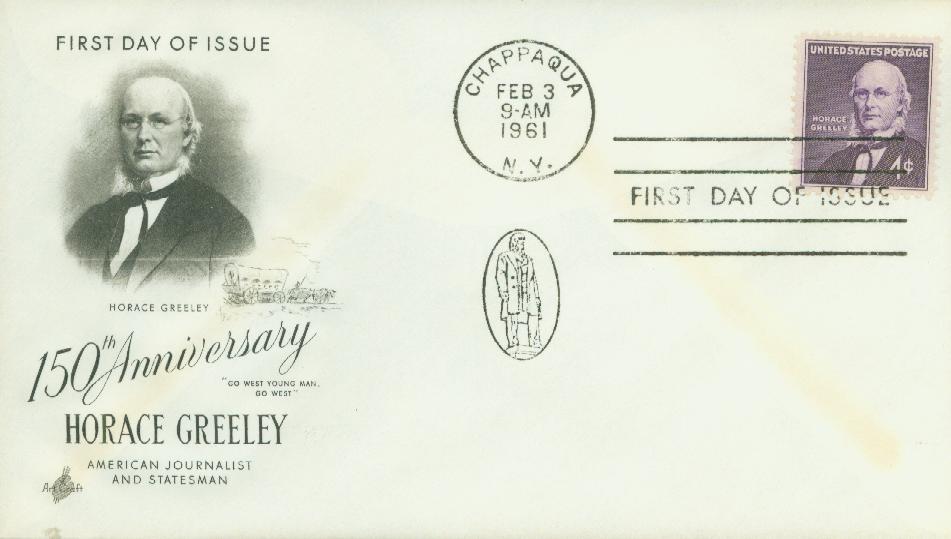
In 1841, Greeley began publishing the New York Tribune, which would help gain him significant national attention. In creating the paper, he announced his intention to “advance the interests of the people, and to promote their Moral, Political and Social well-being.” The Tribune was a “penny daily” paper that set the pattern for modern newspapers. Using the paper as a platform, Greeley championed several causes – abolition, temperance, government support of railroads, and westward expansion. His use of the phrase “Go west, young man” had a profound effect.
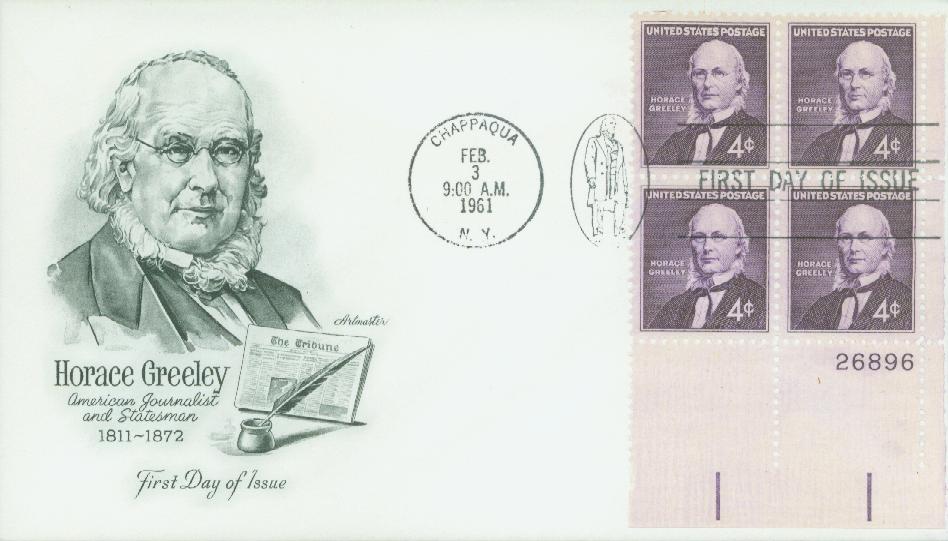
Over time, Greeley merged the Log Cabin and New Yorker into the New York Tribune. By the late 1850s, Greeley had a circulation of over 250,000 though he likely had even more readers than that as many people shared their papers. During the 20 years before the Civil War, Greeley played a major role in shaping American public opinion.

Greeley argued against the expansion of slavery. When the Southern states seceded from the Union, he felt it was not the will of the majority of the citizens but of “a violent, unscrupulous, desperate minority.” Greeley criticized President Lincoln for not taking more aggressive action against the Confederacy. After Lincoln issued his Emancipation Proclamation, Greeley expressed his gratitude. However, Greeley was reluctant to support Lincoln’s reelection in 1864, which lost him some support.

After the war, Greeley shared his support for the equality of freedmen and the impeachment of President Andrew Johnson. He also wanted to restore relations with the South, recommending Jefferson Davis’ release from prison. He sponsored experiments in cooperative living, including the founding of Greeley, Colorado, in 1869. This utopian community flourished, partially due to Greeley’s insistence that settlers have solid finances.
Greeley then grew unhappy with the Grant administration and ran against him in the election of 1872. Greeley lost the election, winning only six states. By the time the election was over, Greeley had surrendered much of his control of the Tribune to others. The loss of the election and control of his paper, as well as the death of his wife, led Greeley to have a breakdown and he died on November 29, 1872.
4¢ Horace Greeley
City: Chappaqua, NY
Quantity: 98,616,000
Printed by: Bureau of Engraving and Printing
Printing Method: Rotary Press
Perforations: 10 1/2 x 11
Color: Dull violet
Birth Of Horace Greeley
The son of a farmer and day laborer, Greeley received limited schooling until he was 14. After that, he found work as an apprentice with a newspaper editor in Vermont.
Greeley remained in the newspaper business, taking jobs in New York and Pennsylvania. Then in 1831, he sought to improve his life and returned to New York. He worked a variety of jobs for a while before he had enough money to start his own literary and news journal, the New Yorker.
Greeley’s New Yorker proved popular, but not lucrative, so he made extra money writing more on the side, in particular for the Whig Party. His support of the party and close connections to Whig leaders helped him become editor of the Whig publication, the Log Cabin. Under his leadership, the Log Cabin reached about 90,000 readers and helped William Henry Harrison win the presidency and Greeley gain influence.

In 1841, Greeley began publishing the New York Tribune, which would help gain him significant national attention. In creating the paper, he announced his intention to “advance the interests of the people, and to promote their Moral, Political and Social well-being.” The Tribune was a “penny daily” paper that set the pattern for modern newspapers. Using the paper as a platform, Greeley championed several causes – abolition, temperance, government support of railroads, and westward expansion. His use of the phrase “Go west, young man” had a profound effect.

Over time, Greeley merged the Log Cabin and New Yorker into the New York Tribune. By the late 1850s, Greeley had a circulation of over 250,000 though he likely had even more readers than that as many people shared their papers. During the 20 years before the Civil War, Greeley played a major role in shaping American public opinion.

Greeley argued against the expansion of slavery. When the Southern states seceded from the Union, he felt it was not the will of the majority of the citizens but of “a violent, unscrupulous, desperate minority.” Greeley criticized President Lincoln for not taking more aggressive action against the Confederacy. After Lincoln issued his Emancipation Proclamation, Greeley expressed his gratitude. However, Greeley was reluctant to support Lincoln’s reelection in 1864, which lost him some support.

After the war, Greeley shared his support for the equality of freedmen and the impeachment of President Andrew Johnson. He also wanted to restore relations with the South, recommending Jefferson Davis’ release from prison. He sponsored experiments in cooperative living, including the founding of Greeley, Colorado, in 1869. This utopian community flourished, partially due to Greeley’s insistence that settlers have solid finances.
Greeley then grew unhappy with the Grant administration and ran against him in the election of 1872. Greeley lost the election, winning only six states. By the time the election was over, Greeley had surrendered much of his control of the Tribune to others. The loss of the election and control of his paper, as well as the death of his wife, led Greeley to have a breakdown and he died on November 29, 1872.






